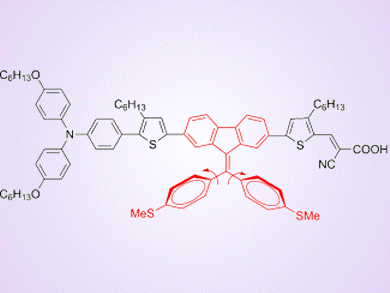For an organic sensitizer to obtain a broad and intense spectral coverage, an extensive and planar conjugation system is needed. However, the elongation of the π-conjugated system usually causes the formation of aggregates owing to strong intermolecular interactions. These significantly lower the power-conversion efficiency.
Zhen Li, Qianqian Li, and co-workers, Wuhan University, China, have designed a series of diphenyldibenzofulvene (DPDBF)-bridged organic sensitizers with extensive conjugation systems. The three-dimensional configuration of DPDBF not only elongates the conjugated system, which benefits the light harvesting, but also suppresses the aggregation and electron recombination.
Thus, the dilemma mentioned above can be partially resolved. Moreover, as the absorption properties of the sensitizers can be tuned by the electron-donating or electron-withdrawing substituents on the DPDBF unit, their photovoltaic performance can also be manipulated by the substituents to some degree.
The team hopes to use this new insight into the molecular design of sensitizers to develop new organic compounds with superior power-conversion efficiencies.
- Diphenyldibenzofulvene-Based Sensitizers for Efficient Dye-Sensitized Solar Cells: The Tuned Absorption Properties and Partially Suppressed Aggregation,
Huiyang Li, Runli Tang, Yingqin Hou, Yizhou Yang, Junnian Chen, Linfeng Liu, Hongwei Han, Tianyou Peng, Qianqian Li, Zhen Li,
Asian J. Org. Chem. 2014, 3, 176–184.
DOI: 10.1002/ajoc.201300231




